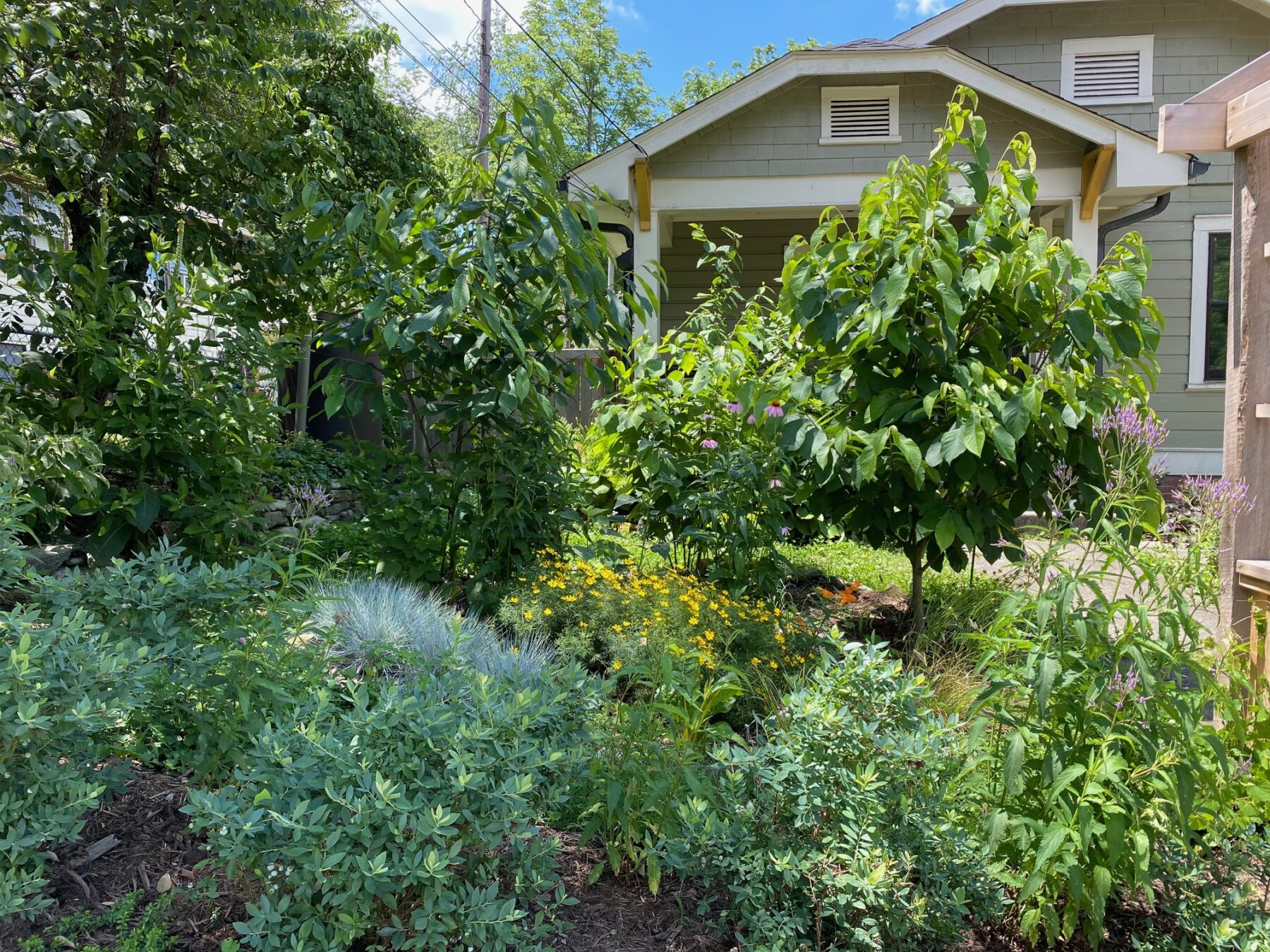
April Showers Bring May Flowers—and Runoff
You’ve likely heard these words since kindergarten. While that might not be the exact wording, it’s true that rain becomes runoff when hard surfaces prevent it from soaking into the ground — and our developed landscapes are designed to move water off site as quickly as possible, so it often collects in unnaturally large amounts. In urban areas, runoff is piped untreated into our waterways, bringing with it sediment, litter, and other pollutants that it picks up along the way. As homeowners, business owners, gardeners, or anyone who stewards land, you play a critical role in what happens to rain once it reaches the ground. With the power of observation and thoughtful design, you can help ensure the rain doesn’t become runoff and spring showers nourish May flowers instead.
I Spy With My Little Eye
The first step in managing runoff is to observe your property during a rain. It can be useful to sketch your observations on a printout of your property from Google Maps/Earth. The ruler tool on these apps can also help you measure distances from buildings and septic fields. As you observe, document any hard surfaces that are shedding water (roof, driveway, patio, etc.) and where that water is going. Look for opportunities to direct water to an area where it can soak into the ground.
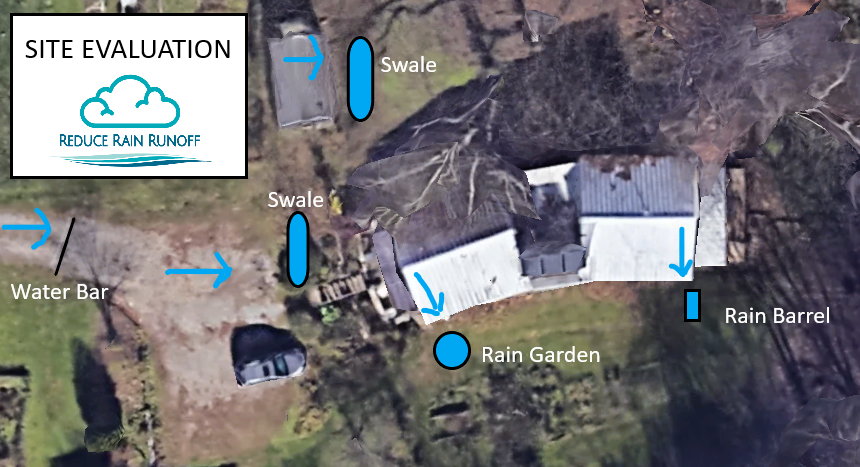
There are lots of options for this redirection. Rain gardens and swales are depressions dug into the landscape that are designed to hold water for short periods of time until it soaks in. These features should be situated downhill and at least 10 ft. from building foundations and 25 ft. from a septic field. If you plan to harvest rainwater, note the condition of your gutters and identify areas where a rain barrel can safely overflow when it is full. Bonus points if you install multiple rainwater capturing features to maximize your runoff reduction! Learn more about site evaluation in our WaterRICH Guide.
Capture the Rain
An estimated 25-50% of total water usage on residential and commercial sites goes towards irrigating landscapes. This can lead to costly water bills. Why not install a rain barrel to capture the “free” rainwater falling on your roof and use it to water the lawn, garden, or houseplants? A rain barrel is a storage container used to collect rainwater, typically from a rooftop via a series of pipes, for later use. Commercially available rain barrels are made of plastic, stainless steel, or repurposed wooden barrels like those used by wineries or distilleries. Rain barrels come in all sizes, depending on your watering needs and budget. Some gardeners find that a 55-gallon rain barrel fills quickly and doesn’t provide enough water for their needs.
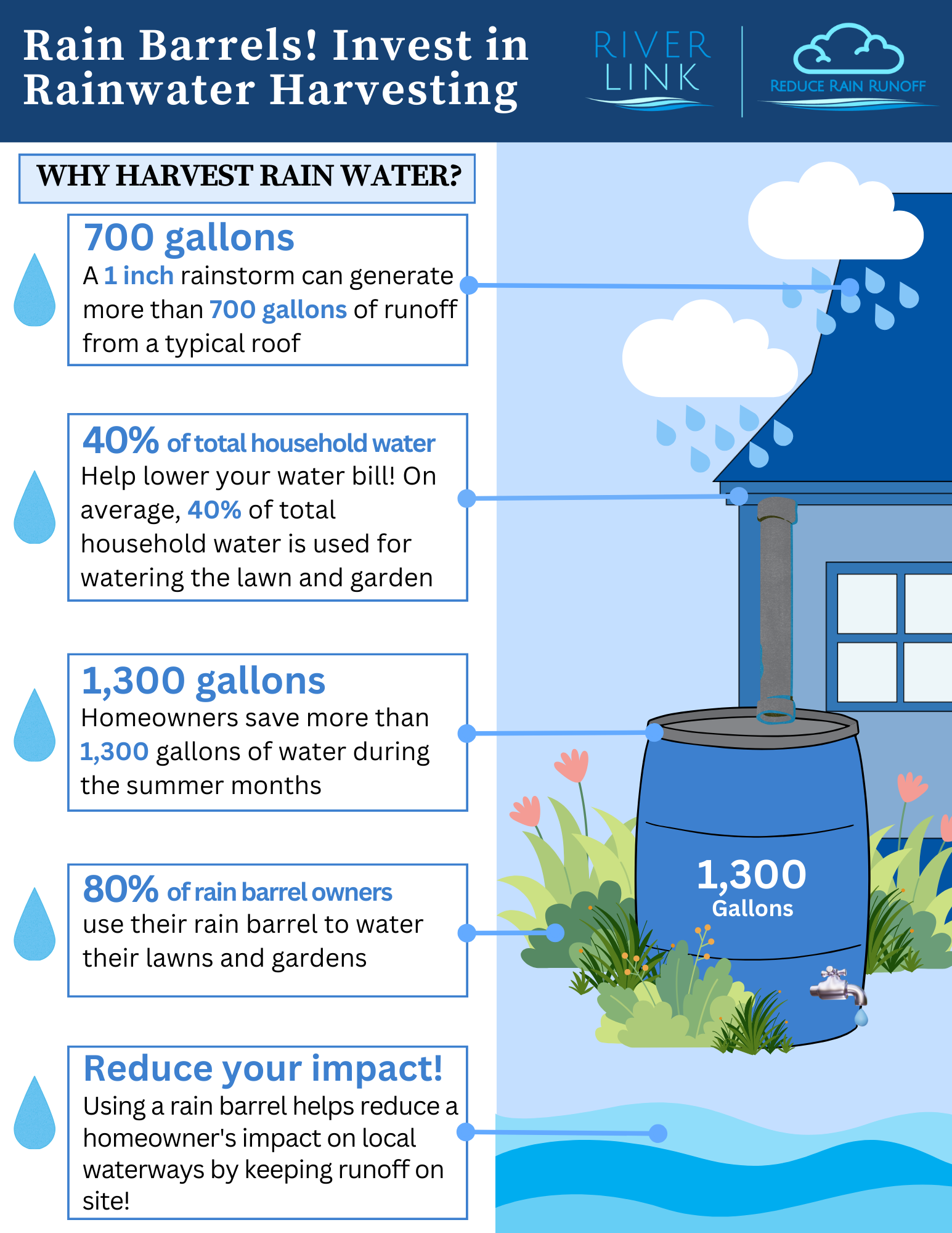
If you have extensive irrigation needs, you may opt for a 500-gallon storage tank or link multiple smaller barrels together. Regardless of the rain barrel size, be sure to install it in a convenient location for watering and where it can safely overflow when full. If you are looking for a budget-friendly rain barrel, check out our guide and instructional video to build your own.
Did You Know?

A 1,000 square foot roof can provide 30,000 gallons of free water (with no added chlorine!) for irrigation during an average year of rainfall.
Rainscaping
Rainscaping is a way to manage runoff by designing your landscape to keep rain on site where it nourishes plants and soaks into the ground. Rain gardens are like any other landscaped bed, except they are designed to collect and store water long enough for it to soak into the ground. They are bowl-shaped features that receive runoff from a rooftop downspout or any hard surface that sheds water. Filled with native plants that tolerate dry and wet periods, rain gardens provide an attractive habitat for birds and pollinators.
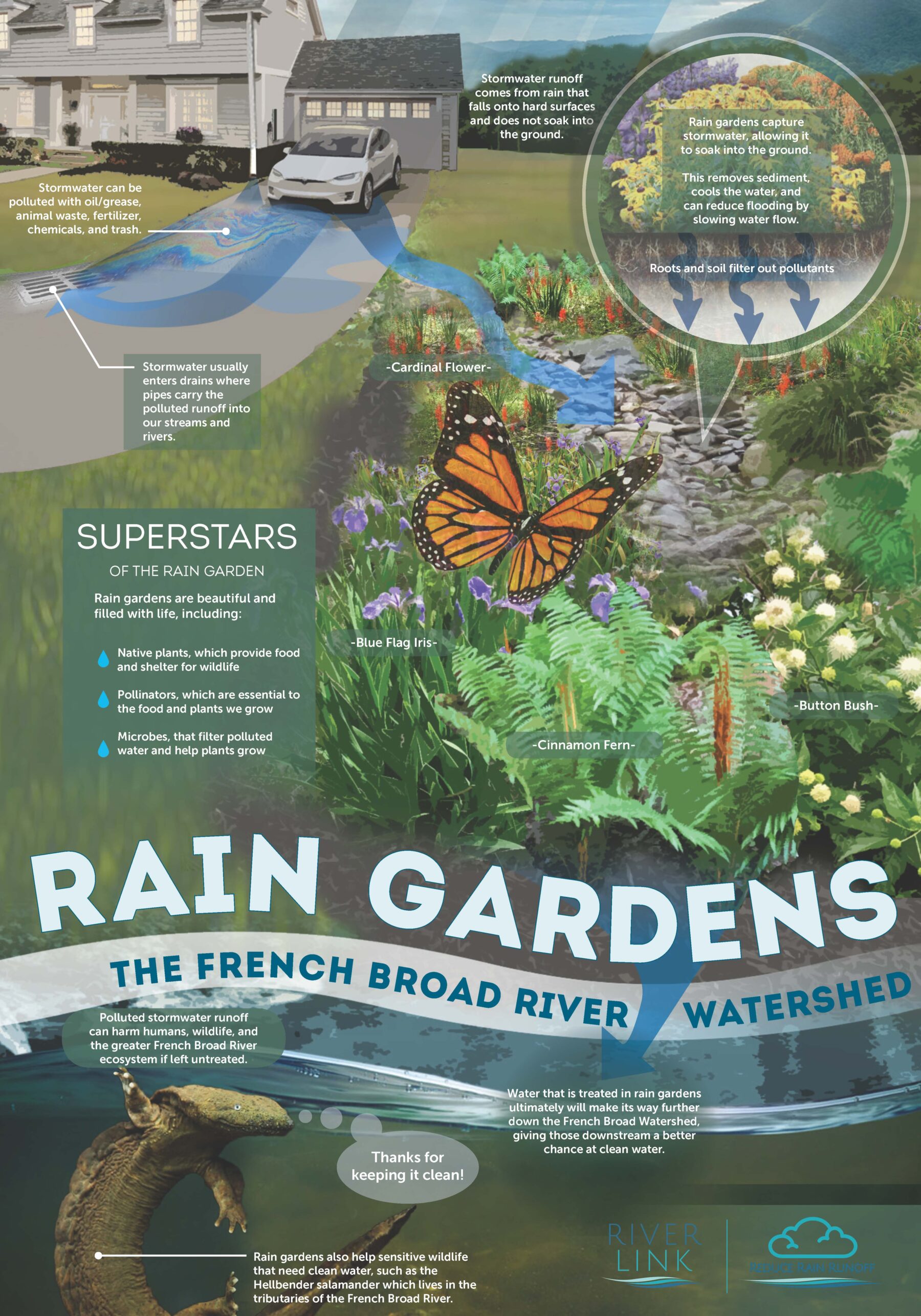
The keys to a successful rain garden include proper site selection, size, and plant choice. Rain gardens are sized to catch the first inch of rainfall in a bowl that is 12-13 inches deep, with a footprint that is at least 10% of the area draining into it. For example, a rain garden that collects runoff from a 500-square-foot roof should be at least 50 square feet in size (500 sq ft X 0.1). If you have the space and want a larger rain garden, there is no harm in going bigger. Avoid building on steep slopes and select a site with soils that drain in 72 hours or less.
For steeper slopes, you still have the option of creating a swale. Swales are linear rain gardens built on contour (that is, perfectly level across the slope). Often, people build multiple swales that are interconnected so that when one fills, it overflows downhill to the next swale. See our guides to rain gardens and swales for a simple soil drainage test, plant list, and other construction tips.
Other Ways to Let Nature Treat Our Stormwater
From permeable pavers to waterbars, there are many creative solutions to reducing rain runoff from the hard surfaces around our properties. Permeable pavement is an attractive alternative to concrete or asphalt for patios, sidewalks, and driveways. Depending on the situation, there are several options to choose from. Permeable pavers allow water to seep into the spaces between the pavers and through layers of gravel and sand below. The pavers themselves can be traditional brick, concrete, or plastic grids filled with a permeable material like gravel or planted with grass and can be used for driveways and parking lots. In general, permeable pavers are not recommended for slopes greater than 1-2%.
Of course, many driveways in our mountainous region are on steeper slopes and unpaved – but there are green solutions for these situations too. Water bars are narrow channels that can be created across a driveway or natural surface trail to intercept water, slow it down, and direct it to an area where it can soak into the ground. They can be prefabricated structures or simply cut from the soil and reinforced with gravel. The distance between water bars depends on the slope of the driveway. Homeowners may lack the technical expertise, equipment, or desire to install these options themselves. See our WaterRICH Guide for a list of professional designers and landscape contractors that can help with water management projects.
Plant a Tree
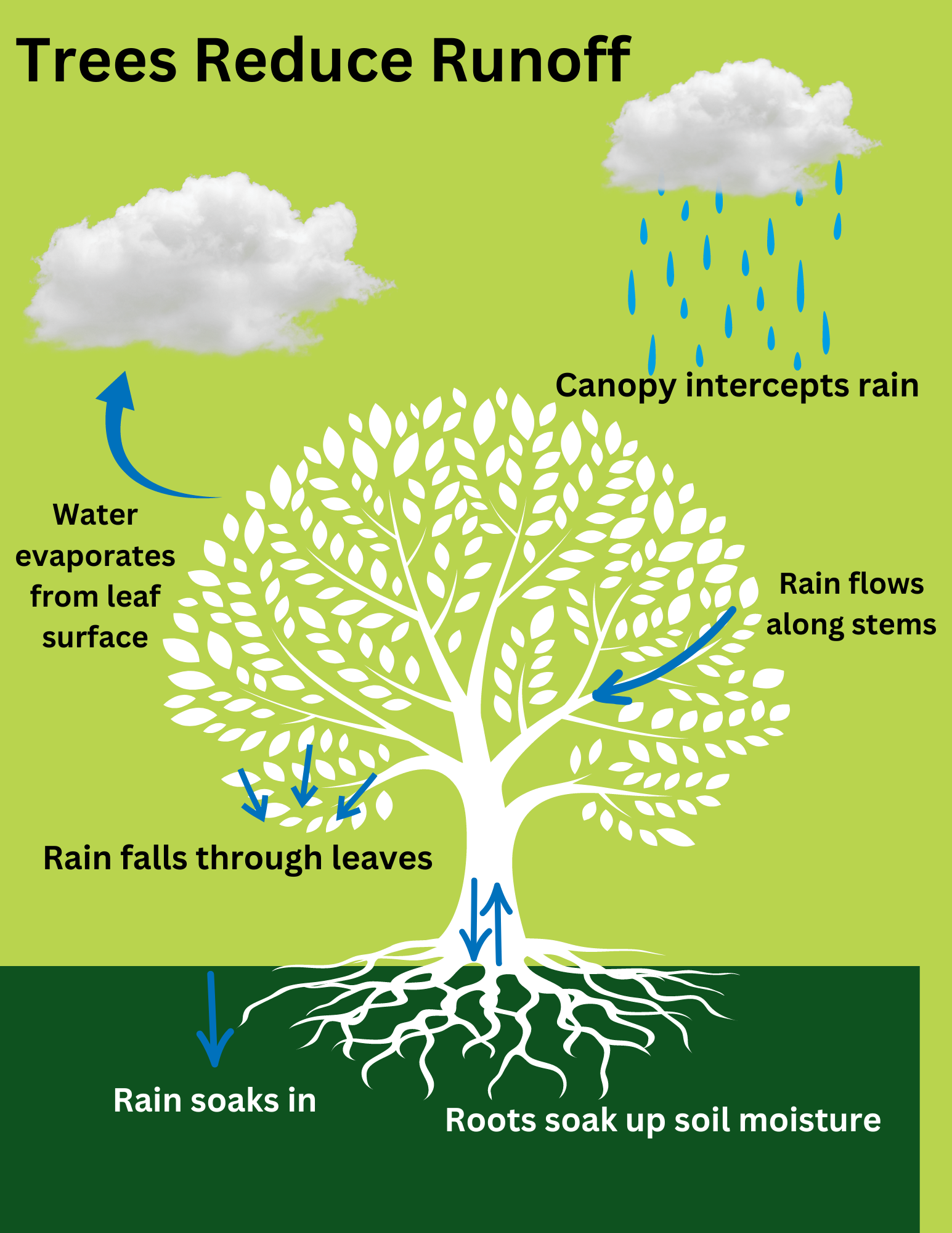
Trees are considered green infrastructure, as they can be super useful in managing stormwater runoff. As rain falls on the canopy of a tree, the leaves intercept the rain drops, slowing down the potential erosive force as they gather. Rain then flows off the leaf surface and along the branches and trunk of the tree where it can soak into the ground and be taken up by the tree roots. Of course, trees provide many additional services from the cooling benefits of their shade, cleaner air, carbon capture, and food for wildlife, to name just a few.
Did You Know?

A single tree can prevent up to 3,000 gallons of runoff a year.
Flowing waters tie us together more steadily than any other natural force. If spring showers have been creating problems on your property…or if you’re just looking to lower your water bill and boost the natural functionality of your landscaping…April is a great time to make plans for harnessing the rainwater in your life. Clean water in the French Broad is quite literally on us!
Resources
- Permeable Pavement
- Green Roads for Water
- 7 Driveway Drainage Solutions– See Dry Well, French Drain, and Dry Creek Bed/Swale
- Trees Help Reduce Runoff

How Can You Help?
Ready to learn more? Head over to our Take Action page to learn more about simple ways you can reduce rain runoff at your residence or business.
